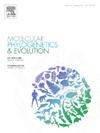Testing evolutionary hypotheses for the world’s main hotspot of temperate alpine flora using Saussurea (Compositae) as a model
IF 3.6
1区 生物学
Q2 BIOCHEMISTRY & MOLECULAR BIOLOGY
引用次数: 0
Abstract
The Tibet–Himalaya–Hengduan region (THH) harbours the world’s richest temperate alpine flora. To investigate the main evolutionary and ecological processes underlying this outstanding biodiversity, we tested multiple hypotheses focusing in Saussurea (Compositae), a representative genus of ca. 450 species that extensively diversified in THH and adjacent regions. We built a highly-resolved phylogeny based on hundreds of nuclear loci and a broad sampling (70 % of genus richness). We integrated phylogenetic, ecological, geographic, topographic and climatic data with biogeographic and diversification modelling methods. Our results suggest that Hengduan Mountains acted both as evolutionary cradle and museum. Repeated bidirectional biogeographic exchanges between Asian regions substantially contributed to current biodiversity patterns. Uplift and mountain building established favourable conditions for later evolutionary radiations by providing high topographic heterogeneity. However, orogeny alone does not explain the evolutionary radiation of Saussurea and its diversification burst in the Late Miocene with a double-fold increase in speciation rate. Besides orogeny, the main factors associated with current biodiversity are: (1) the interplay of steep altitudinal gradients and topographic heterogeneity with moderate climatic oscillations during the Late Miocene; (2) relative climatic stability during Pleistocene dramatic climatic oscillations, which may have reduced extinction rates; and (3) sufficient annual precipitation (>400 mm).

以雪莲(菊科)为模型,对世界温带高山植物区系主要热点的进化假设进行检验。
西藏-喜马拉雅-横断地区(THH)拥有世界上最丰富的温带高山植物群。为了探讨这种突出的生物多样性背后的主要进化和生态过程,我们以雪莲属(Saussurea (Compositae))为中心,对多个假设进行了验证。雪莲属是在THH及其邻近地区广泛分布的约450种代表性属。我们基于数百个核位点和广泛的采样(70% %的属丰富度)建立了一个高度分辨的系统发育。我们将系统发育、生态、地理、地形和气候数据与生物地理和多样化建模方法相结合。研究结果表明,横断山脉既是演化的摇篮,也是演化的博物馆。亚洲地区之间反复的双向生物地理交流对当前的生物多样性格局有重要贡献。隆起和造山为后期的演化辐射提供了高度的地形异质性。然而,造山运动本身并不能解释雪莲属植物的演化辐射及其多样性在晚中新世爆发,物种形成速率增加了两倍。除造山运动外,影响当前生物多样性的主要因素有:(1)晚中新世的陡峭海拔梯度和地形异质性与温和的气候振荡的相互作用;(2)更新世剧烈气候振荡期间的相对气候稳定性,可能降低了物种灭绝率;(3)年降水量充足(> 400 mm)。
本文章由计算机程序翻译,如有差异,请以英文原文为准。
求助全文
约1分钟内获得全文
求助全文
来源期刊
CiteScore
7.50
自引率
7.30%
发文量
249
审稿时长
7.5 months
期刊介绍:
Molecular Phylogenetics and Evolution is dedicated to bringing Darwin''s dream within grasp - to "have fairly true genealogical trees of each great kingdom of Nature." The journal provides a forum for molecular studies that advance our understanding of phylogeny and evolution, further the development of phylogenetically more accurate taxonomic classifications, and ultimately bring a unified classification for all the ramifying lines of life. Phylogeographic studies will be considered for publication if they offer EXCEPTIONAL theoretical or empirical advances.

 求助内容:
求助内容: 应助结果提醒方式:
应助结果提醒方式:


